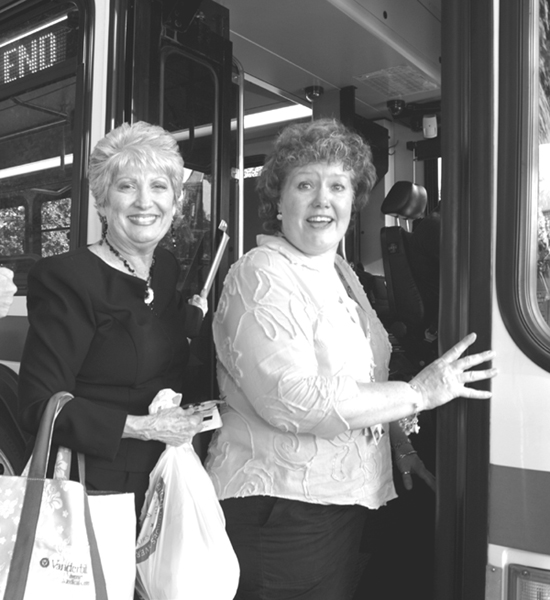|
The View from
the Bellevue Bus
VUMC employees save money and enjoy the ride
By Wayne Wood

Sally Kaplan and Patti Reilly board the Bellevue bus for home.
When Vanderbilt began offering free bus rides for employees a couple of years ago, Patti Reilly and Sally Kaplan found themselves at the same information table at the same time asking about the same bus route—Bellevue.
“Reilly said, ‘I’m from Bellevue, too—you’re my new best friend!’” Kaplan, who works in Plastic Surgery, remembers.
And that’s pretty much how it has worked out. Reilly and Kaplan are the heart of a group of Vanderbilt staff who ride together every day with the University paying the fare, and along the way they have, indeed, become close.
Some of the riders meet for dinner about once a month, inquire after each other if somebody hasn’t been on the bus for a day or two, and even pitched in to raise money after one of their regular Metro Transit Authority (MTA) drivers had her home destroyed in a tornado last year.
“We call each other ‘bus friends’ instead of ‘best friends,’” Kaplan says. Kaplan, originally from Los Angeles, had some previous bus-riding experience. Not everybody was such a transit veteran, though.
“I had never ridden a bus before in my life,” says Reilly, who works in Obstetrics and Gynecology. “But my car was, like, 10 years old and I didn’t want to buy a new car.”
And she hasn’t. Her 1994 Honda Civic is still going strong, partly because it isn’t making a daily trip from Bellevue to VUMC.
“I buy gas maybe once every six weeks,” Reilly says. “My car insurance went down. I only drove 3,000 miles last year. This was the first year I didn’t renew my parking sticker.” Reilly estimates that she has saved thousands of dollars in gasoline, parking fees, insurance and car maintenance—not to mention getting a few more years out of her aging car.
“Even if it wasn’t free, I’d probably still ride the bus,” she says.
Kaplan notes that the bus gives riders a chance to get other things done. “We can sleep, read, open junk mail, do our bills—not to mention the camaraderie with other Vanderbilt people on the bus,” she says. Reilly says she listens to the radio using a headset on the way to work, while the afternoon ride home is more for socializing and catching up with her “Bellevue bus buddies.”
The program to provide free rides to Vanderbilt staff and faculty on their way to and from work began in July 2004. It was Metro’s first employer-subsidized fare arrangement, although since, other employers, most notably the state of Tennessee, have followed Vanderbilt’s lead. Employees swipe the magnetic strip on their IDs when they board the bus, and MTA bills the University for each rider at the rate charged to holders of a monthly bus pass.
Officials say that the plan not only is a way for employees to give themselves extra cash in transportation savings, but also helps the University by reducing the congestion and parking needs on campus.
“Vanderbilt decided some time back that it would be best not to cover the campus with parking lots and garages,” says VUMC director of Plant Operations Ken Browning, who helped bring the MTA program to Vanderbilt. Browning also points to a larger, positive result from the program: “The free ride program is also an opportunity for Vanderbilt to assist the community to reduce air pollution levels.”
About 450 Vanderbilt employees per day take advantage of the free bus ride, so that represents day by day, a lot of cars not on campus and a lot of internal combustion engines not running.
Both Kaplan and Reilly say the time it takes them to get to work from home is about the same as when they drove themselves. Kaplan drives from home and leaves her car at a supermarket parking lot on Highway 70 and boards the bus there. Reilly has things even easier: “I walk out, walk three doors down to the end of my street, catch the bus, and it drops me off on West End [by the University],” she says.
The women also say their bosses—Frank Boehm, M.D., in the case of Reilly, and Bruce Shack, M.D., in Kaplan’s case—are accommodating when it comes to being a little flexible about work hours to meet the bus schedules. They both get to work a little earlier and leave a little earlier, but work the same number of hours as when they drove themselves.
“We all truly enjoy the fact that Vanderbilt has given this to us,” Kaplan says. —Additional reporting on this story by Paul Govern
|